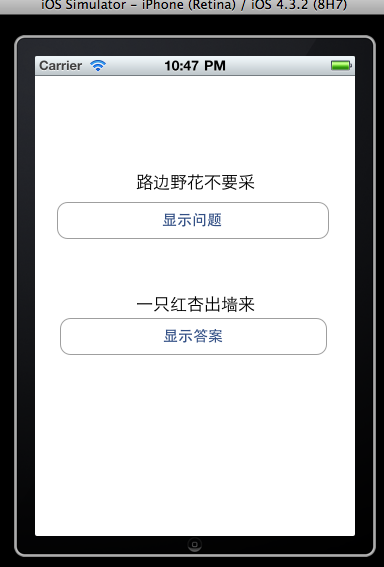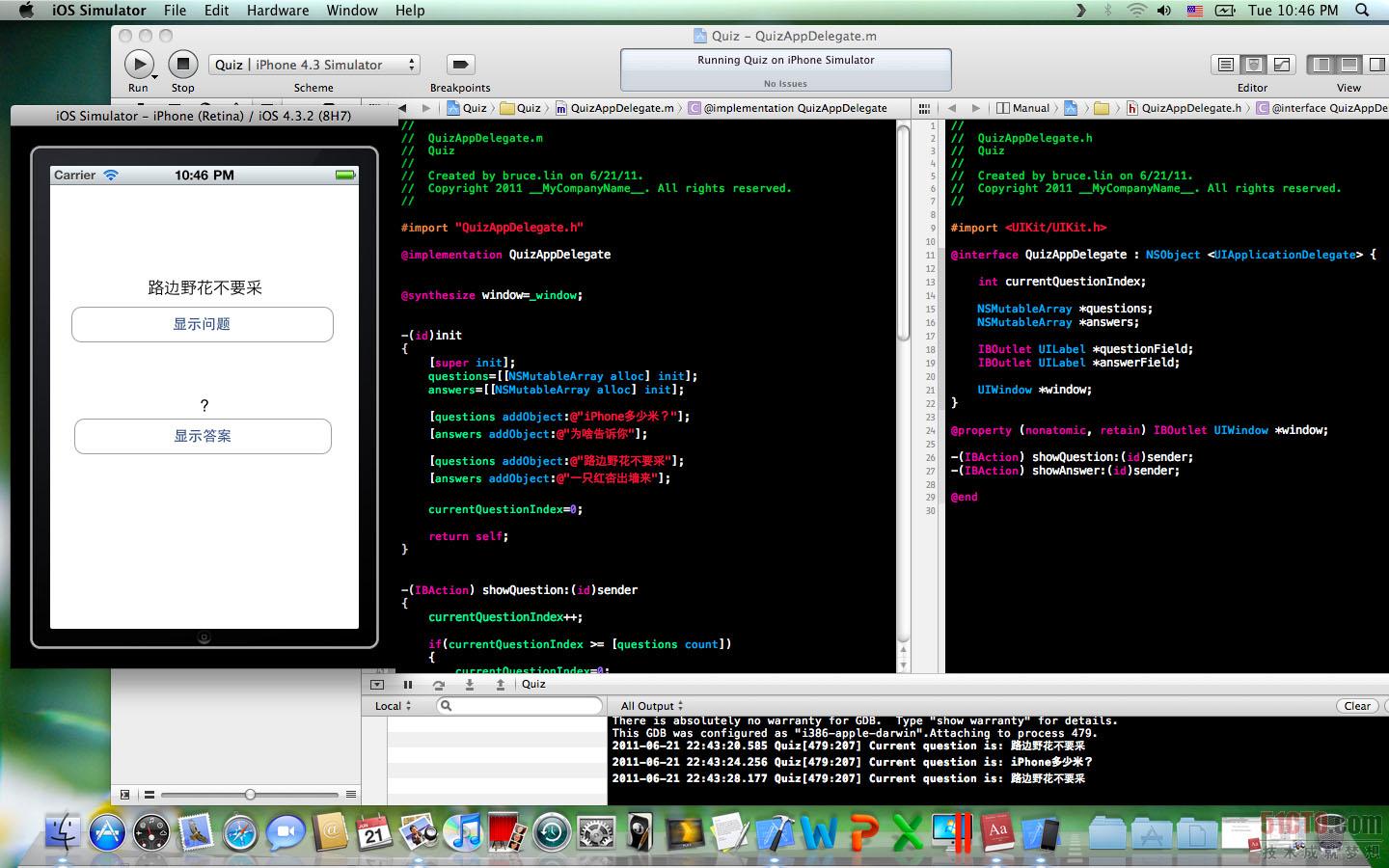详解iPhone开发入门教程 新手必看是本文要介绍的内容,本文是在坛子上看到的一篇关于iphone开发基础教程的,主要讲解iphone开发的思想和一些简单的实现。来看详细内容。先来推荐一篇 iPhone开发入门教程 图解,可以作为参考!
思路:
(1)Interface Builder制作界面
(2)头文件中增加Outlet和事件响应函数
(3)建立界面与代码的关联
(4)添加实际代码(初始化、按键响应等)
效果: (第二张图单击可放大)


代码:
Java代码
- //
- // QuizAppDelegate.h
- // Quiz
- //
- // Created by bruce.lin on 6/21/11.
- // Copyright 2011 __MyCompanyName__. All rights reserved.
- //
- #import <UIKit/UIKit.h>
- @interface QuizAppDelegate : NSObject <UIApplicationDelegate> {
- int currentQuestionIndex;
- NSMutableArray *questions;
- NSMutableArray *answers;
- IBOutlet UILabel *questionField;
- IBOutlet UILabel *answerField;
- UIWindow *window;
- }
- @property (nonatomic, retain) IBOutlet UIWindow *window;
- -(IBAction) showQuestion:(id)sender;
- -(IBAction) showAnswer:(id)sender;
- @end
- //
- // QuizAppDelegate.m
- // Quiz
- //
- // Created by bruce.lin on 6/21/11.
- // Copyright 2011 __MyCompanyName__. All rights reserved.
- //
- #import "QuizAppDelegate.h"
- @implementation QuizAppDelegate
- @synthesize window=_window;
- -(id)init
- {
- [super init];
- questions=[[NSMutableArray alloc] init];
- answers=[[NSMutableArray alloc] init];
- [questions addObject:@"iPhone多少米?"];
- [answers addObject:@"为啥告诉你"];
- [questions addObject:@"路边野花不要采"];
- [answers addObject:@"一只红杏出墙来"];
- currentQuestionIndex=0;
- return self;
- }
- -(IBAction) showQuestion:(id)sender
- {
- currentQuestionIndex++;
- if(currentQuestionIndex >= [questions count])
- {
- currentQuestionIndex=0;
- }
- [questionField setText:[questions objectAtIndex:currentQuestionIndex]];
- NSLog(@"Current question is: %@",[questions objectAtIndex:currentQuestionIndex]);
- [answerField setText:@"?"];
- }
- -(IBAction) showAnswer:(id)sender
- {
- [answerField setText:[answers objectAtIndex:currentQuestionIndex]];
- }
- - (BOOL)application:(UIApplication *)application didFinishLaunchingWithOptions:(NSDictionary *)launchOptions
- {
- // Override point for customization after application launch.
- [self.window makeKeyAndVisible];
- return YES;
- }
- - (void)applicationWillResignActive:(UIApplication *)application
- {
- /*
- Sent when the application is about to move from active to inactive state.
- This can occur for certain types of temporary interruptions
- (such as an incoming phone call or SMS message) or when the user quits the application and it begins the transition to the background state.
- Use this method to pause ongoing tasks, disable timers,
- and throttle down OpenGL ES frame rates. Games should use this method to pause the game.
- */
- }
- - (void)applicationDidEnterBackground:(UIApplication *)application
- {
- /*
- Use this method to release shared resources, save user data, invalidate timers,
- and store enough application state information to restore your application to its current state in case it is terminated later.
- If your application supports background execution, this method is called instead of applicationWillTerminate: when the user quits.
- */
- }
- - (void)applicationWillEnterForeground:(UIApplication *)application
- {
- /*
- Called as part of the transition from the background to the inactive state;
- here you can undo many of the changes made on entering the background.
- */
- }
- - (void)applicationDidBecomeActive:(UIApplication *)application
- {
- /*
- Restart any tasks that were paused (or not yet started) while the application was inactive.
- If the application was previously in the background, optionally refresh the user interface.
- */
- }
- - (void)applicationWillTerminate:(UIApplication *)application
- {
- /*
- Called when the application is about to terminate.
- Save data if appropriate.
- See also applicationDidEnterBackground:.
- */
- }
- - (void)dealloc
- {
- [_window release];
- [super dealloc];
- }
- @end
小结:详解iPhone开发入门教程 新手必看的内容介绍完了,通过本文介绍的iphone开发基础,是不是学习到了一些内容,那么希望本文对你有所帮助!
























